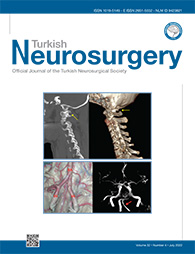2Istanbul Medeniyet University, Department of Pediatric Nephrology, Istanbul, Turkey
3Baskent University-Istanbul Hospital, Department of Neurosurgery, Istanbul, Turkey DOI : 10.5137/1019-5149.JTN.36527-21.2 AIM: To determine the clinical value of anocutaneous reflex (AR) in children with neurogenic bladder due to spina bifida (SB).
MATERIAL and METHODS: Patients who were diagnosed with SB were prospectively evaluated; moreover, AR and bulbocavernous reflex were examined. Patients were divided into those with and without AR. Age, gender, diagnosis, ventriculoperitoneal shunt presence, symptomatic urinary tract infections, leg movements, clean intermittent catheterization and anticholinergic therapy, lesion level, urodynamic detrusor, and sphincter activity were evaluated. Chi-square test and univariate regression analysis were done. The AR value was evaluated by two by two contingency table.
RESULTS: This study evaluated 217 patients (109 boys and 108 girls). AR was present and absent in 53 and 164 patients, respectively. Anticholinergic therapy was necessary in 37.7% and 23.8% of patients with and without AR (p=0.015), respectively. Patients with AR had higher lesion level (p=0.005), more detrusor overactivity, and less detrusor underactivity (p=0.007). Less detrusor sphincter dyssynergia (DSD) was noted in patients with AR (p=0.029). AR specificity was 83%, and positive predictive value in predicting detrusor overactivity and DSD was 76% and 80, respectively.
CONCLUSION: AR determination is a valuable and simple tool in neurogenic bladder. This report delineates the clinical significance of this reflex and is the largest cohort describing this significance. This simple examination should not be skipped in the initial evaluation and follow-up of these patients.
Keywords : Spina bifida, Neurogenic bladder, Anocutaneous reflex, Children




